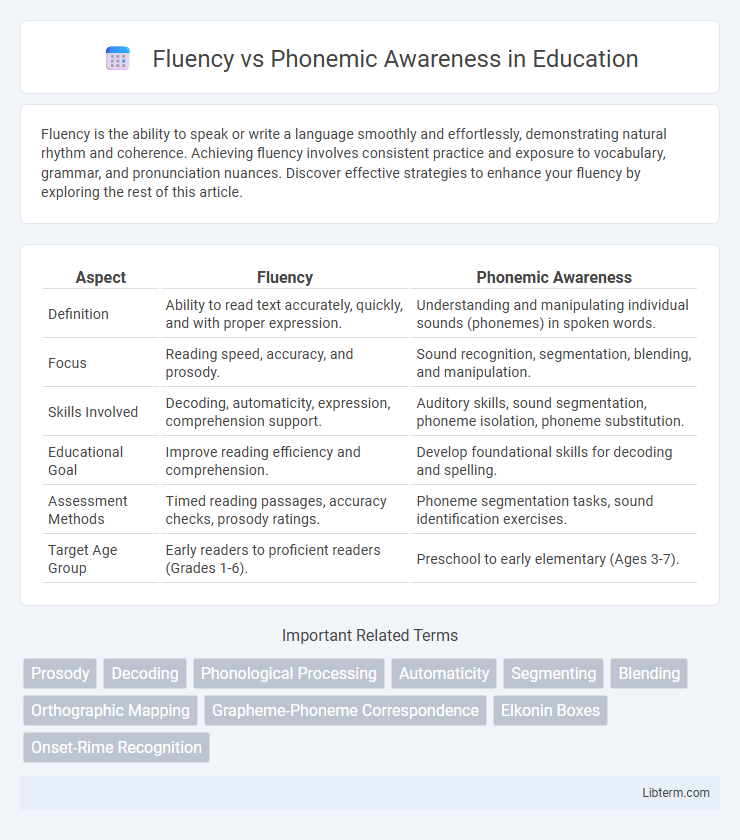Fluency is the ability to speak or write a language smoothly and effortlessly, demonstrating natural rhythm and coherence. Achieving fluency involves consistent practice and exposure to vocabulary, grammar, and pronunciation nuances. Discover effective strategies to enhance your fluency by exploring the rest of this article.
Table of Comparison
| Aspect | Fluency | Phonemic Awareness |
|---|---|---|
| Definition | Ability to read text accurately, quickly, and with proper expression. | Understanding and manipulating individual sounds (phonemes) in spoken words. |
| Focus | Reading speed, accuracy, and prosody. | Sound recognition, segmentation, blending, and manipulation. |
| Skills Involved | Decoding, automaticity, expression, comprehension support. | Auditory skills, sound segmentation, phoneme isolation, phoneme substitution. |
| Educational Goal | Improve reading efficiency and comprehension. | Develop foundational skills for decoding and spelling. |
| Assessment Methods | Timed reading passages, accuracy checks, prosody ratings. | Phoneme segmentation tasks, sound identification exercises. |
| Target Age Group | Early readers to proficient readers (Grades 1-6). | Preschool to early elementary (Ages 3-7). |
Understanding Fluency and Phonemic Awareness
Fluency involves the ability to read text accurately, quickly, and with proper expression, which enhances overall comprehension and communication skills. Phonemic awareness refers to the understanding that spoken words are composed of individual sounds or phonemes, essential for decoding and spelling in early literacy development. Mastery of phonemic awareness serves as a foundation for developing reading fluency, linking sound recognition to smooth and expressive reading.
Key Differences Between Fluency and Phonemic Awareness
Fluency involves the ability to read text accurately, quickly, and with proper expression, whereas phonemic awareness is the skill of recognizing and manipulating individual sounds, or phonemes, in spoken words. Fluency integrates decoding skills, vocabulary, and comprehension, while phonemic awareness solely focuses on auditory discrimination and sound segmentation without involving written text. The key difference lies in fluency being a bridge to reading comprehension, and phonemic awareness serving as a foundational auditory skill critical for decoding and early reading development.
The Role of Fluency in Reading Development
Fluency plays a crucial role in reading development by enabling readers to recognize words quickly and accurately, which enhances comprehension and overall reading efficiency. Unlike phonemic awareness, which focuses on the ability to identify and manipulate individual sounds in spoken words, fluency bridges decoding skills and understanding by promoting automaticity in word recognition. This automaticity allows cognitive resources to be allocated toward processing meaning rather than decoding, making fluency a key predictor of reading success in early literacy acquisition.
Why Phonemic Awareness Matters for Early Learners
Phonemic awareness is crucial for early learners as it directly supports the development of decoding skills necessary for reading fluency. Mastery of phonemic awareness enables children to recognize and manipulate individual sounds in words, laying the foundation for accurate word recognition and spelling. Without strong phonemic awareness, learners often struggle with reading fluency, leading to difficulties in comprehension and academic progress.
Assessing Fluency: Tools and Techniques
Assessing fluency involves measuring oral reading rate, accuracy, and expression through tools such as timed readings, fluency rubrics, and digital applications that track reading metrics. Phonemic awareness assessments often use phoneme segmentation and blending tasks to evaluate a learner's ability to manipulate sounds, critical for early reading development. Combining fluency and phonemic awareness assessments provides a comprehensive understanding of reading proficiency and highlights specific areas needing intervention.
Evaluating Phonemic Awareness in Young Readers
Evaluating phonemic awareness in young readers involves assessing their ability to recognize and manipulate individual sounds in words, a skill critical for developing reading fluency. Tools such as phoneme segmentation, blending exercises, and rhyming tasks provide measurable data on a child's phonemic proficiency. Early identification of phonemic awareness levels supports targeted interventions, improving decoding skills and overall reading success in early literacy development.
Effective Strategies to Build Reading Fluency
Effective strategies to build reading fluency integrate phonemic awareness by emphasizing the connection between sound recognition and smooth, expressive reading. Techniques such as guided oral reading, repeated reading, and phonics-based exercises improve decoding skills and automaticity. Incorporating multisensory activities that target phoneme segmentation and blending directly supports fluent reading development by reinforcing the foundational sound structures of language.
Activities to Strengthen Phonemic Awareness
Activities to strengthen phonemic awareness include segmenting, blending, and manipulating sounds within words, which are essential for decoding skills in reading fluency. Games like sound matching, rhyming, and phoneme substitution encourage children to listen attentively and differentiate individual sounds. Repeated practice with these activities enhances auditory discrimination and supports the foundation for fluent reading and spelling.
Integrating Fluency and Phonemic Awareness in the Classroom
Integrating fluency and phonemic awareness in the classroom enhances reading proficiency by combining rapid word recognition with the ability to hear, identify, and manipulate phonemes. Targeted activities like guided oral reading paired with phoneme segmentation exercises improve decoding skills and automaticity, fostering both accuracy and speed. Research shows students who engage in integrated fluency and phonemic awareness practices demonstrate stronger reading comprehension and overall literacy outcomes.
Common Challenges and Solutions in Developing Both Skills
Common challenges in developing fluency and phonemic awareness include difficulty in decoding words quickly and accurately, as well as struggles with distinguishing and manipulating individual sounds within words. Targeted interventions such as explicit phonics instruction, repetitive reading exercises, and phoneme segmentation activities can enhance these skills effectively. Consistent practice with multisensory learning tools and immediate feedback helps bridge gaps between sound recognition and fluent reading, fostering stronger literacy foundations.
Fluency Infographic

 libterm.com
libterm.com